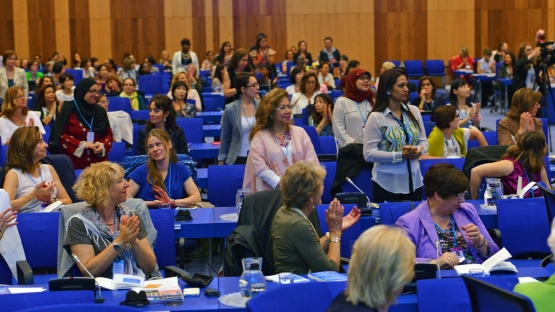Too little has happened in terms of gender equality in the nuclear field since the days of Marie Curie, and now is the time to change that, argued participants at a Women in Nuclear conference organized in cooperation with the IAEA this week.
Women, as scientists, engineers, safeguards inspectors, managers and lawyers play a key role in the IAEA, form an invaluable resource for a sustainable future of nuclear fields, and they must be better integrated in the workforce, IAEA Director General Yukiya Amano said in a statement to the more than 450 mostly female professionals taking part in the worldwide non-profit association’s annual conference hosted this year at the IAEA.
“It is very important that women should be well-represented in the nuclear field. The IAEA is committed to increasing the representation of women at all levels within the Agency, and especially in senior positions,” he said in his message.
Women in Nuclear (WiN) has chapters across the globe, with one based at the IAEA. The Middle East and Africa recently saw new chapters established, highlighting that opportunities for female nuclear professionals are expanding.
“Despite radioactivity being discovered by a woman, nuclear science is dominated by men,” said Margaret Mkhosi, president of WiN South Africa and senior specialist in nuclear engineering at the country’s National Nuclear Regulator. “For Africa to progress there is a need for greater awareness of women’s central role in contributing towards the development of each country.”
Speakers from the IAEA and national governments, regulatory bodies, research centres, and non-governmental organizations discussed topics such as nuclear technology, environment and climate change, as well as safeguards and non-proliferation, during plenary meetings and topical sessions.
IAEA Deputy Director General Janice Dunn Lee, the first female Head of the Agency’s Department of Management, highlighted the importance of using networking opportunities such as this conference.
“Networks are an extremely effective way of reaching a diverse pool of qualified candidates, many of whom might never have considered working in the nuclear field,” she said. “Probably very few women with a humanities background like mine would think of making a career in the nuclear field. Maybe not too many with a science background would either. And this is something that I — and I hope many others here today — would like to change.”
Striking a Gender Balance
Statistics on gender equality paint a bleak picture for science, technology, engineering, and math fields, but female participation rates in the nuclear sector are slowly rising. The IAEA recorded an increase in the numbers of female applicants: applications for regular posts, including science and engineering positions, increased from a quarter to almost a third of the total over the last six years. Yet, considerable efforts are still needed to fill the gender gap. The IAEA is committed to increasing the representation of women at all levels within the Agency, and especially in senior positions, Dunn Lee said.
Women in Nuclear: A Global Movement for a Global Change
WiN Global has 25 000 members from more than 100 countries that are organized in chapters. The association, founded in 1992, aims to be a support network to women working in nuclear-related fields around the world.
--------------------------------
Luisa Milani contributed to this article.





